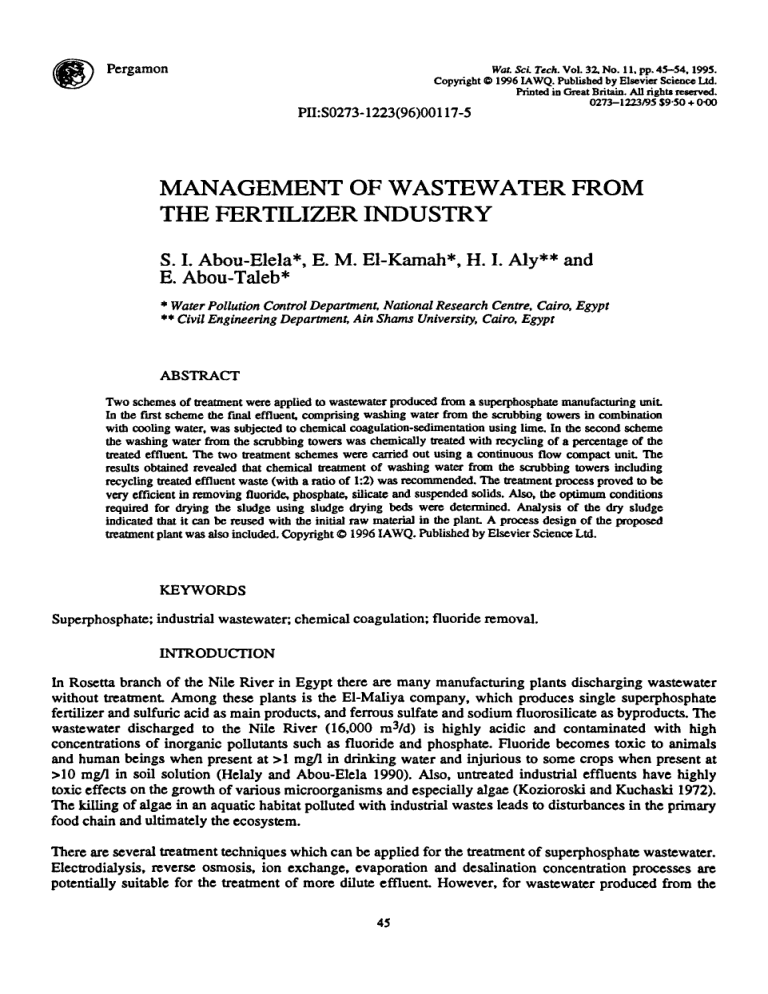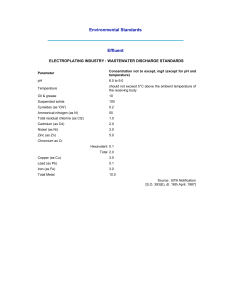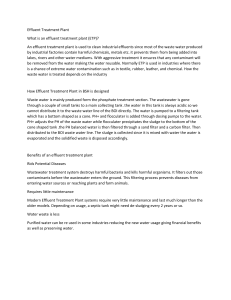
8) Pergamon War. Sci. Tech. Vol. 32, No. II, pp. 4S-54, 1995. Copyright C> 1996IAWQ. Published by ElsevierScienceLtd. Printed in GreatBritain. Allrights reserved. 0273-1223195 $9'50 + 0-00 Pll:S0273-l223(96)00117-5 MANAGEMENT OF WASTEWATER FROM THE FERTILIZER INDUSTRY S. I. Abou-Elela*, E. M. EI-Kamah*, H. I. Aly** and E. Abou-Taleb* • WaterPollution Control Department, National Research Centre, Cairo, Egypt •• CivilEngineering Department, Ain ShamsUniversity, Cairo, Egypt ABSTRACT Two schemes of treatment were applied to wastewaterproduced from a superphosphatemanufacturing mit In the flrst scheme the fmal effluent, comprising washing water from the scrubbing towers in combination with cooling water, was subjected to chemical coagulation-sedimentation using lime. In the second scheme the washing water from the scrubbing towers was chemically treated with recycling of a percentage of the treated effluent The two treatment schemes were carried out using a continuous flow compact unit The results obtained revealed that chemical treatment of washing water from the scrubbing towers including recycling treated effluent waste (with a ratio of 1:2) was recommended.The treatment process proved to be very efficient in removing fluoride, phosphate, silicate and suspended solids. Also. the optimum conditions required for drying the sludge using sludge drying beds were determined. Analysis of the dry sludge indicated that it can be reused with the initial raw material in the plant A process design of the proposed treatment plant was also included. Copyright 0 1996IAWQ. Publisbedby Elsevier Science Ltd. KEYWORDS Superphosphate; industrial wastewater; chemical coagulation; fluoride removal. INTRODUCTION In Rosetta branch of the Nile River in Egypt there are many manufacturing plants discharging wastewater without treatment Among these plants is the El-Maliya company, which produces single superphosphate fertilizer and sulfuric acid as main products, and ferrous sulfate and sodium fluorosilicate as byproducts. The wastewater discharged to the Nile River (16,000 m 3/d) is highly acidic and contaminated with high concentrations of inorganic pollutants such as fluoride and phosphate. Fluoride becomes toxic to animals and human beings when present at >1 mg/l in drinking water and injurious to some crops when present at >10 mg/l in soil solution (Helaly and Abou-Elela 1990). Also, untreated industrial effluents have highly toxic effects on the growth of various microorganisms and especially algae (Kozioroski and Kuchaski 1972). The killing of algae in an aquatic habitat polluted with industrial wastes leads to disturbances in the primary food chain and ultimately the ecosystem. There are several treatment techniques which can be applied for the treatment of superphosphate wastewater. Electrodialysis. reverse osmosis. ion exchange. evaporation and desalination concentration processes are potentially suitable for the treatment of more dilute effluent However. for wastewater produced from the 45 S. I. ABOU-ELELA et aL 46 scrubbing towers, chemical coagulation-sedimentation using lime and lime aided with polyelectrolyte provedto be successful techniques(Schoeman et a11988). In this study segregationand treatmentof wastewaterfrom the superphosphate unit was investigated. MATERIALAND METHODS Sourcesof Wastewaterin the Company As a result of a plant survey it was found that the main source of pollution is the wastewater from the superphosphate production unit. Other wastewater in the plant, cooling water from the sulfuric acid production unit, is relatively clean (6000 m3/day). In the superphosphate production unit there are two sources of wastewater, namely cooling water from the sulfuric acid dilution unit (3600 m3/day) and the wastes produced from the washing of the scrubbing towers (1200 m3/day). The wastewater from the three scrubbing towers (50 m3/hr) is discharged to the drainage system in open circuit operation (Fig. lA). When sodium fluorosilicic acid (NaZSiF&> is to be produced, a closed system is employed (Fig. lB). Accordingly, only IS m3/batehld is producedand dischargedto the drainage system as a shock load. Fresh H20 ~ Chimney -. SiF4 C02 3 HF Storage Tank I!==::..-+ Waste Figure IA. Open circuit technique in the superphosphate unit. TreatabilityStudies Two schemes of treatmentwere investigatedas follows. Scheme I. In this scheme the final effluent from the superphosphate unit was subjected to chemical coagulation-sedimentation using lime as a coagulant.Lime is added mainly to raise the pH of the wastewater to 9.3 ± 0.2. The optimum pH value which gave the best removal of fluoride and phosphate was determined using ajar test procedure (Cohen 1957). Scheme II. In this scheme treatment of washing water from the scrubbing towers mixed at different recycling ratios with the treated effluent was carried out. The recyclingratio was varied between0.5 and 4.0 Q. 47 Management of wastewaterfrom fertilizerindustry Fresh ~O + Chimney l!===-.Waste Pump Figure lB. Closed circuit technique in thesuperphosphate unit Treatment Unit A schematic diagram and specification of the treatment unit are given in Fig. 2 and Table 1. The unit was operated at a hydraulic load of 18.89 m3tm3tday. Table 1. Specificationof the treatment unit Dimensions Volume Flow rate Detention time Flasb mwn& tank IOx7xS em depth 3S0 em 3 Flocculation tank ISxlOX30 em depth 4S00 em 3 Sedimentation tank 4OXlSx2S em deoth ISOOOem3 SUb 4.2 min SUb S4min SUb 180 min . Slud!:e DO'in!: Beds A laboratory-scale unit simulating sludge drying beds was designed and manufactured to determine the optimum conditions for drying the sludge. The unit consisted of three PVC columns fixed in a wooden rack. A schematic diagram of the unit used is shown in Fig. 3. The volume of the sludge applied to the bed was calculated according to the followingequation: volume of sludge applied = surface area of column x depth of sludge. To obtain the optimum conditions required to get 60% moisture content, different sand depths (12-20 em) were used at a fixed sludge volume of one litre. Another experiment was carried out by changing the sludge volume from 1 to 2 litres while the sand zone was fixed at 17 em depth. The experiments were repeated four times with different quantities of the sludge. In each run the sludge moisture content was determined daily and for a duration of 8 days. S. I. ABOU·ELELA et aL 48 40 5 lI'I Outlet I--=~.-' o N Sec. Elevation f-t I~~i ! ----------[r~t 40 ~-f . - u.: I I Plan Figure 2. Aschematic diagram of thetreatment unit Analysis The physico-ehemical parameters includedthe following: electric conductivity (BC), total dissolved solids at 105°C(TSS), total residue at 105°C (fR), total dissolved solids at 105°C (IDS), turbidity (NTIJ), 'total phosphate (TP), soluble silicate (Si02) fluoride (F-) sulfate (S04-)' chloride (CI-), total Kjeldahl nitrogen (TKN) and calcium (Ca++). Also, sludge analysis was performed. The physico-chemical characterizations werecarried out accordingto StandardMethods(American Public Health Association 1991). RESULTS Characterization of Wastewater Analysis of wastewater from the different sources of pollution in the company is shown in Table 2. Physico-ehemical analysisof wastewater produced from the scrubbing towersshowed a wide variation in the wastewater characteristics. The data indicated that the wastewater is highly acidic. The pH varied from 0.7 to 2.06. It also contains a high concentration of phosphate: values reached as high as 308 mg/l with an averagevalue of 107mg/l. It was found that the majorpollutantis fluoride. Its concentration ranged between 49 Management of wastewater fromfertilizer industry 80 and 13500 mg/l according to the daily operation. Suspended solids content was as high as 1227 mg/l. Moreover, the waste contains a considerable concentration of dissolved solids which represents71.4% of the total residue,calculatedon an average basis. I d 0 o I ;; E ~ .... "ON CII"" .g'1 ::>..n lilo "ON § I Vl~ E .... ~1i'\,~J;:~i ..n e-, Figure 3. Aschematic diagram of thedrying sand bed. Althoughwashing water from the scrubbing towers represents only 3.6% of the total wastewaterdischarged from the plant, its influencecan be seen clearly in the quality of the end-of-pipe effluent The average values of the total suspendedsolids.silicate and phosphate were 100 mg/l, 154 mg/l and 36.5 mg/l, respectively. Table 2. Characterization of wastewater from differentsources in the company WasteWllter ParamClcn Coolinc watar froID lulCurie odd unit CooUnc Wllter from luporpholphote unit Waste'MIter from Krubblnc to_n W.ste. .ter from IUpOrphOlphote unit Average Rang. Average Rmg. AVcrBge ".3 339-1114 33$-1026 23-63 0.$-2.0 H·17.$ 1$.0-$2.8 408 31H 486 37.3 1.116 10.21 31.1 0.7-2.1 4200-38000 1891-4460 917-3674 182-1227 2$-308 120-8000 28-2200 1492$ 3117 2226 70$ 107 3480 $28 2.8 1900-3300 872-1364 723-11" 31-24$ 108-90 g$-363.6 N.D-420 2$48 1088 988 100 36$ 1$4.2 108 N.D N.D-\.6 0.3 80-13$00 32$7 . . Rang. Average Rang. 70-8 I 480-2000 336-1$73 20$·1209 1$.$-610 0.3-6.4 6.$049.1 31.1-66 00 1231 108J 861 178.$ 2.3$ U3 zoo-soo N.D moIL DH EC TR TOS TSS TP S'02 SO 2· 4 F' 69·7 Cooling water from the superphosphate unit was relatively clean. The pH is around 7, while the electrical conductivity values were in the range between 200 and 600 mho/em. The average values of total solids, so S. I. ABOU-ELELA et aL chloride, silicate and phosphate were 514, 260, 10.0 and 1.2 mgll, respectively. These results are in the normal ranges of boiling blowdown contaminants (Sittig Marchal 1979). Analysis of cooling water from the sulfuric acid manufacturing process indicated that the only contaminants are the inorganic salts which are represented by the EC value. It ranged between 480 and 2000 mho/em with an average value of 1231 mho/em. This value may be attributed to the use of groundwater in combination with Nile water as a source of cooling water in this department. Average concentrations of chloride, silicate and sulfate were 271, 25 and 55 mgll, respectively. Treatment of Wastewater from the Superphosphate Department Batch scale treatment. A jar test procedure was applied to obtain the optimum pH and coagulant dose which produced the best removal of both fluoride and phosphate. Chemical treatment of the final effluent of the superphosphate unit using a dose of lime of 2.5 gil at a pH of 9.0 gave satisfactory results (Table 3). Moreover, the results obtained in Table 4 indicated that the treatment of washing water of the scrubbing towers required a dose of lime equivalent to 12.1 gil. Table 3. Chemical treatment of the final effluent from the superphosphate department using lime Parameters, mgIL Samole Dose or lime pH NTU TR TDS TSS II'" SiOl TP Ca l + l!'1L - R.W.W· crs« 1.9 9.2 2.5 61 1.S 1010 879 849 854 115 24 2925 28.5 250 35 22 1.3 248 320 *R. W. W: Raw Wastewater ** erE: Chemically Treated EjJ1uenl Table 4. Chemical treatment of washing water of scrubbing towers using lime (Q =50 m 3/h ) Parameten mgIL Dose or lime gIL pH Samole R.W.W crs . 12.1 0.97 9.2 NTU TR 450 2.8 3435 2259 TDS 2614 2247 TSS 821 12 II'" 3750 35.5 SiOl 5000 100 TP caJ+ 80 N.D 1 710 However, recycling of the treated wastewater with pH around 9.0 is expected to raise the pH of the raw wastewater; accordingly it will reduce the dose of lime required for the mixture. Recycling with 50-75% of treated effluent (Fig. 4) was satisfactory to obtain a significant reduction (50 %) in the total lime dose required per hour. Continuous flow chemical treatment. Based on the results obtained from batch scale treatment, a continuousflow chemical treatment was carried out using a recycling ratio of treated waste of 200% of the influent waste. The obtained data showed that the treatment process is very efficient in removing fluoride, phosphate, silicate and suspended solids (Table 5). Average percentage removal values of phosphate and suspended solids were 97.3% and 90.3%, respectively. Although the fluoride percentage removal value reached 99.7%, the average residual value was 52.6 mgll. This problem was solved by mixing the treated effluent with cooling water from both the superphosphate and the sulfuric acid units. Managementof wastewaterfran fertilizerindustry ... s: <, C7' CIo 1Il 0 '0 x 0 51 Run 1 Run 2 800 600 CIo .~ - X a ,2 200 0k----t---+---+---+-....... 4 Fraction of recycled treated waste. Q Figure4. Determination of optimum recycled treatedwater. Table S. Results of chemicaltreatment of washing waterfrom scrubbing towerswitha recycling ratio of 1:2 (Doseof lime 1.7 gil). Parameters m&fL Minimum Maximum Averaze- Samples Raw W.W. Final effluent Raw W.W. Final effluent Raw W.W. Final effluent pH 1.2 4200 130 2101 1618 182 28 1680 760 91 800 2.1 23400 200 3737 2917 820 160 13500 6500 9.3 2000 12 2958 2883 75 1.7 67.5 105 1.6 11600 159.5 2707 2198 509.3 55.8 5120 3340 9.1 137 4.3 222 218 45 1.4 52.6 83 E.e. eOD TR TOS TSS TP F' Si02 N.D 1757 1745 11.5 0.8 37 53 ·Ave7'ag' of 4 runs The concentration of fluoride after dilution with cooling water was almost nil (Table 6). The fluoride concentration specified in the National Regulatory Standards Act 48 (1982) for wastewater disposal into the River Nile is 0.5 mg/l. Arora and Chattopadhya (1974) found that for industrial effluent discharged into inland surface water a threshold limit of 2.0 mgll is recommended. Also, it has been found that industrial effluents containing fluoride up to 10 mgll have no detrimental effect whatsoever on soil and plants when usedfor irrigation purposes. A general layoutof the proposed treatment plant is shownin Fig. 5. 52 S. I. ABOU-ELELA tt al. Sludge Drying t 5.1.5 1~;-:·~·11 wa~ewa~rr1~~~ Cooling Water From Different 3/hrl Departments (400 m 1.5.1.5 ~1 From Scrubbln Towers 3 H Q= 30 m IIY' 10 Clari- FIoc:c:ulator RIC)'Cled Treated Waste I 2Q Dim. in: m Table 6. Characterization of treated effluent after mixing with cooling water from different departments Parameters, m&fL Samnles 1 2 Slud~e DO'in~ pH TR TDS TSS TP Sial F" 73 7.02 831 562 825 529 5.6 33 N.D N.D 11.8 15.0 N.D N.D Beds The optimum design parameters for sand drying beds were determined. The results obtained in Figs 6 and 7 showed that increasing the depth of the sand layer up to 20 em improved the filterability of the sludge. The corresponding maximum depth of sludge on drying beds was 32 cm. Also it was found that a 6 day drying period was sufficient to reduce the sludge moisture content to 60%. However, increasing the drying period from 6 days to 8 days did not improve the sludge dewaterability. Therefore, a 6 day drying period was considered optimum to achieve the maximum dewaterability. Air temperature is considered one of the main design criteria governing the efficiency of drying beds (Eckenfelder 1989). Air temperature during the drying period varied between 24.8°C and 36°C. The results obtained indicated that there is no dramatic effect of the temperature on the efficiency of the drying beds. This may be attributed to the fact that air temperature during this period of the study (September-OCtober) was changing within a narrow range. This cannot be the case in wintertime as the drying period must be increased. Slud~e Reuse The sludge produced from the chemical unit was analyzed for the possibility of its reuse with raw material in the plant. Analysis of the chemical sludge indicated that the constituents are almost inorganic in nature. It contains 62.5% CaF2. 3% CaCI2, 6.6% Si02 and 19.4% Ca5(OH)(PO~3' Therefore the dried sludge can be reused with the phosphate rock by the company. Management of wastewater from fertilizerindustry S3 80 C ~ c 75 0 u "QI 70 (; ::;: ~ 55 Depth of Sand • IS em x 17 em o 20 em 60 3 4 S Time. days Figure 6. Sludgedewaterability at differentlayersof sand and fixeddepth of sludge. 7S c c ~ 70 C' u "~ 5S « 50 ~ Depth of Sludge • lS.7 em x 23.5 em o 31.S em Time •days Figure7. Sludgedewaterability at differentdepthof sludgeand fixed depth of sand. CONCLUSION It was found that the main source of pollution from the plant was washing water from the scrubbing towers. Therefore segregation and treatment of this wastewater is carried out via chemical coagulation-sedimentation using lime. To minimize the dose of lime, recycling of a part of the treated effluent was recommended: the recycling ratio was I :2. The treated effluent can be discharged safely into the public sewerage network. However, for other purposes the treated effluent should be mixed with cooling water from other departments in the plant. Also, the sludge produced after treatment can be dried and reused with the raw material in the plant. ACKNOWLEDGMENT The authors would like to acknowledge the Science and Technology Cooperation (STC) board for offering the grant under which this work was carried out. This grant was part of the STC program grant number 263.0016 between the Government of the Arab Republic of Egypt and the United States of America. S. I. ABOU-ELELA et al; 54 REFERENCES American Public Health Association (1991). Standard Methods/or The Examination o/Water and Wastewater. 17th edn, APHA, Washington. Arora, H. C. and Chattopadhya, S. N. (1974). A study on the effluent disposal of superphosphate fertilizer factory. Indian J. Environ. Health, 16 (2) 140-150 Coheo,J. M. (1957). ImprovedjartesL J. Amer. Waf. WksAss., 491427-1431. Eckenfelder, V. W. lt (1989). Industrial Water Pollution Control. 2nd edn, McGraw-Hill International, Civil Engineering Series. Helaly, A. and Abou-E1ela, S. I. (1990). Protection of surface water from eutrophication via controlled release of phosphate fertilizer. J. Controlled Release 11 39-44. Koziorosld. B. and Kuchaski, I. (1972). Industrial Waste Disposal; English Translation Edition, published by Wydawnietwa Naukowo-Techniczue. Schoeman, J. J.. Buys, I. J. M.. Schutte, I. B. and Macleod, H. (1988). Pilot investigation on the treatment of ferlilizer manufacturing process effluent using lime and electrodialysis reversal Desalination V70. Nl-3, P407 (23). Sittig Marchal (1979). Fertilizer Industry Processes Pollution, Control and Energy Conservation. Mayes-Data Corporation Chemical




